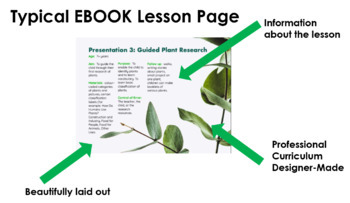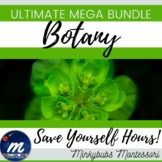BOTANY 1st Knowledge of Plants Stories Riddles Research Montessori MEDIA-RICH
- Open Publication Structure eBook File
Also included in
- Biology focuses on the plants and animals which form part of the environment in which the child lives and continues to develop through experiences they have in it, when they interact with plants and animals.Montessori said, “the world is acquired psychologically by means of the imagination, realityPrice $35.00Original Price $50.99Save $15.99
- ALL Lower and Upper Elementary Montessori Botany 1 and 2 Comprehensive Teaching Materials in my store.Biology focuses on the plants and animals which form part of the environment in which the child lives and continues to develop through experiences they have in it, when they interact with plants andPrice $50.00Original Price $78.99Save $28.99
Description
The First Knowledge of Plants Stories, Riddles, Research, Lesson plans, and exercises are a fun and challenging introduction to the Elementary Montessori Cosmic Curriculum in Biology (Botany).
This is a media-rich, carefully prepared eBook with a link to the PDF for all of the printable material you will need to practice plant research, identification, and classification.
The video preview is of the PDF printable and the thumbnails are from the Ebook.
Plant Stories, Riddles, and Research - The Ebook & The PDF (use it on your devices to take advantage of the stories, digital photos, and videos, use the printables for real life work, or do both!)
This book provides the first knowledge of plants using beautiful photographs, audio narration of the plant stories/riddles, and includes a supplemental download link containing all of the printable resources you need to complete the exercises in the book for parents, teachers, and budding young botanists to use offline.
For each of the 24 plants (listed below) you will have the following for your lessons:
✅between 3 and 6 digital images of each one (Ebook)
✅18 videos showing the plants in motion and in 'real life' (Ebook)
✅The stories are read out loud and embedded in the eBook. You can use this for children who cannot read yet but want to attempt the plant riddles while looking at the pictures of the plant (or not looking at the pictures if they can read) (Ebook)
✅4 Lesson Plans for increasing degrees of complexity (Ebook and PDF)
✅48 beautiful photographs (2 for each plant), plant labels, plant facts/stories/ "Who/what am I?" riddles, Continent labels, and detailed instructions/lesson plans with illustrations (PDF)
✅24 beautiful plant picture cards
⭐⭐⭐There really is nothing else as comprehensive as this out there!⭐⭐⭐
24 diverse and fascinating plants are featured in over 72 high-quality photos and 18 videos. The 24 plant stories/riddles feature audio support. Some of them are common, and some not-so-common. The supplemental material includes printable plant photos, labels, riddles, and lesson plans. The 24 plants featured go into detail about the needs of plants, their basic functions, and their uses for mankind, and more.
This publication features gorgeous photographs, audio reading of the plant riddles, and is beautifully presented.
In addition to the 39 beautiful pages included here, there are an additional 25 pages of supplemental printable material (PDF) for your use offline, for a total of 64 pages with over a hundred different high quality photographs and some videos of plant specimens included.
Direct Aim/Purpose:
✅ To enable the child to identify plants and to learn the vocabulary of plants.
✅ To help identify plants by reading information about them.
✅ To research, discuss, and reason.
✅ To become more knowledgeable about botany/plant classification.
Explore basic botanical facts, through a series of lessons, games, and sorting activities.
⭐⭐⭐ 4 detailed lesson plans with illustrations
⭐ 24 plant picture cards (different pictures from the ebook, so you get 48 more images to use in your lessons:
• cacao
• magnolia
• peach
• bell pepper
• gardenia
• fennel
• blue iris
• bamboo
• tangerine
• brush cherry
• durian
• turnip
• corpse flower
• Antarctic hair grass
• prickly pear
• trumpet pitcher
• plum
• willow
• cape sundew
• lilac
• chive
• olive
• poppy
• butternut squash
⭐ 24 "Who/What am I?" riddle stories (one for each plant)
⭐ 24 nomenclature labels (one for each plant)
⭐ Continent labels in Montessori colours: South America, North America, Asia, Africa, Europe, Oceania, Antarctica)
⭐ A series of question headings and answer cards for a first level of research and plant study
Related Products
• Montessori Botany Experiments 21 Experiments Suitable Homeschool ALL STUDENTS
Biology focuses on the plants and animals which form part of the environment in which the child lives and continues to develop through experiences they have in it, when they interact with plants and animals.
Montessori said, “the world is acquired psychologically by means of the imagination, reality is studied in detail and then the whole is imagined, the detail is able to grow in the imagination and the whole is attained”. These cards give ideas about the natural world which are not able for humans to experience without using the intellect and imagination.
The theme of needs, originating from the work in history, is a key idea in Botany.
Did you know? When you leave feedback for any product you download and/or purchase on TpT, you gain credits that you can use to purchase products on TpT's website.
*Please message me if you have any questions; I am happy to help.
This material has been lovingly created for you by an AMS-trained Montessorian and experienced teacher of more than 2 decades. It complies with and fulfills part of the Montessori Elementary Cosmic Curriculum in Biology (Botany).







